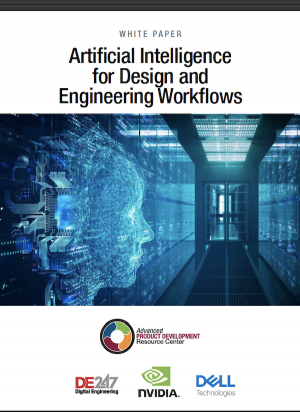Artificial Intelligence Meets Physics
The Altair physicsAI solution leverages NVIDIA RTX™ GPU computing and artificial intelligence to accelerate the design cycle.

Image courtesy of Altair.
Latest News
October 9, 2023
Artificial intelligence (AI) and machine learning (ML) are gaining traction and a lot of attention across industries, and the engineering software space is no exception. A number of leading software vendors have been testing AI-based capabilities for their design and simulation productions, and a few products have been announced.
However, most of this activity is still at a very early stage. One vendor that has demonstrated a live product is Altair, with its physicsAI solution for making fast physics predictions using CAD models and meshes. The solution not only provides very rapid results without the need for a simulation solver, it also benefits greatly from GPU acceleration and can be utilized in a desktop workstation environment.
Altair provided a sneak peek of the product back in February 2023, but offered much more detail at its recent ATCx AI for Engineers virtual event.
Using a process called geometric deep learning, physicsAI allows engineers to evaluate designs and make predictions about performance in a few seconds, without running a simulation solver at all. Accessing the tool within the design environment (in this case, Altair Hyperworks), users can check different physics (like CFD or warpage prediction) hundreds of times faster than they could by running a traditional solver.
This does not eliminate the need for simulation; once a design is complete, engineers can apply the relevant simulation tools to verify design integrity and performance. The benefit is allowing engineers to analyze a wide variety of designs much faster and with greater accuracy prior to the simulation phase, leveraging data from previous simulation and test processes.
The physicsAI product can be provided with data from existing simulations to make predictions about similar products. The simulation data is fed into the solution and then used to train an AI model to test for specific outcomes. Users can then test its performance against known CAE tests to gain confidence in the AI models.
Once the model is trained and tested, the software can make predictions directly from CAD or mesh data in just a few seconds.
In a presentation at Altair’s 2023 Future.Industry conference, Altair Engineering Data Scientist, Eamon Whalen walked attendees through a typical design and test scenario, and explained how physicsAI differs from other machine learning tools in the Altair suite.
For example, Altair HyperStudy requires users to run a design of experiments (DOE), and then train a simple machine learning model where the input is a scalar design variable and the output is a number. HyperWorks Design Explorer also requires a DOE, and the machine learning model generates a contour.
With physicsAI, there is no need for a DOE or manual parameterization; the software can directly evaluate the mesh or CAD and make a prediction.
For engineers, this not only saves the time and cost associated with running full-scale simulations, but they can do much of this work directly on their workstation. According to Altair, smaller models can be created and trained directly on a laptop or desktop.
Larger and more complex models, however, are best handled using HPC or cloud resources, according to the company.
The type of deep learning used to achieve these results relies on the same type of matrix multiplication leveraged, for example, rotating a 3D object in a design program. The highly parallel architecture offered by GPUs can offer the same type of speed improvements in PhysicsAI that users experience when leveraging GPU acceleration for simulation and visualization tasks.
According to benchmark data from Altair and NVIDIA, physicsAI experienced a 14-times speedup on an NVIDIA A100 40GB GPU compared to an 8-core laptop CPU. Using an NVIDIA RTX™ A4000 GPU provided an 8-times speedup for training physicsAI models. In another session, Jonathan Ollar, Product Manager for EDS Products at Altair, noted that while model creation and training can be done using the CPU, the “best performance you get is when you train on GPUs.”
For engineers using professional-grade workstations like Dell Precision tower and desktop models equipped with the latest NVIDIA RTX GPUs, physicsAI provides a way to rapidly evaluate new designs based on past simulations without having to run full-scale simulations, and in many cases without tapping into HPC resources.
According to Ollar, Altair rolled out updates for the physicsAI product in April that included reducing its memory footprint, adding support for both 1D and 3D elements, and providing tools to increase prediction confidence. The company also strengthened the connection of physicsAI for Altair HyperStudy, and has been testing the solution for integration within Altair Inspire and the AltairOne cloud platform.
According to Altair, non-linear dynamic simulations like full vehicle crash are challenging applications, nevertheless Altair is working on such use cases with customers.
You can learn more about physicsAI in this Altair Community posting.
More Altair Coverage
More Dell Coverage

More NVIDIA Coverage
Subscribe to our FREE magazine, FREE email newsletters or both!
Latest News








